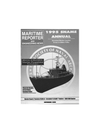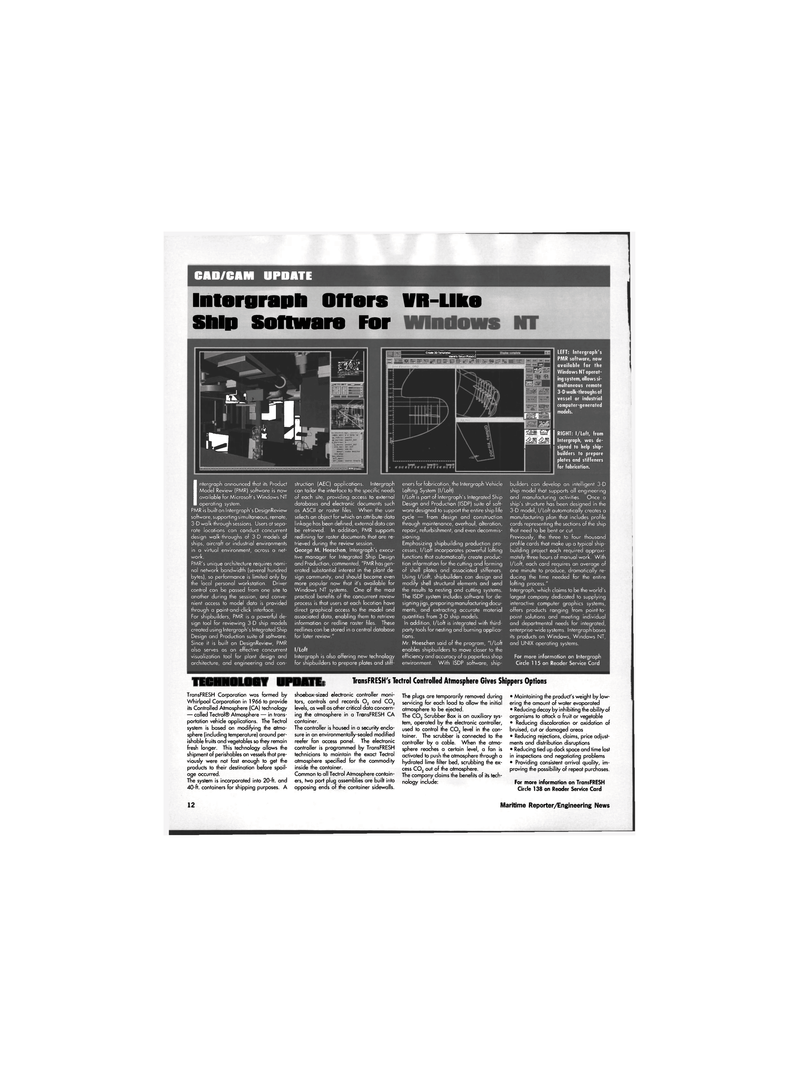
Page 10: of Maritime Reporter Magazine (September 1995)
Read this page in Pdf, Flash or Html5 edition of September 1995 Maritime Reporter Magazine
CAD/CAM UPDATE
Intergraph Offers lfR-Uke
Ship Software For fit
Cr—»3PT*nipUt—
Identify Struct Pl«to(»)| sil * fh —f' -
Intergraph announced that its Product Model Review (PMR) software is now available for Microsoft's Windows NT operating system.
PMR is built on Intergraph's DesignReview software, supporting simultaneous, remote, 3-D walk-through sessions. Users at sepa- rate locations can conduct concurrent design walk-throughs of 3-D models of ships, aircraft or industrial environments in a virtual environment, across a net- work.
PMR's unique architecture requires nomi- nal network bandwidth (several hundred bytes), so performance is limited only by the local personal workstation. Driver control can be passed from one site to another during the session, and conve- nient access to model data is provided through a point-and-click interface.
For shipbuilders, PMR is a powerful de- sign tool for reviewing 3-D ship models created using Intergraph's Integrated Ship
Design and Production suite of software.
Since it is built on DesignReview, PMR also serves as an effective concurrent visualization tool for plant design and architecture, and engineering and con- struction (AEC) applications. Intergraph can tailor the interface to the specific needs of each site, providing access to external databases and electronic documents such as ASCII or raster files. When the user selects an object for which an attribute-data linkage has been defined, external data can be retrieved. In addition, PMR supports redlining for raster documents that are re- trieved during the review session.
George M. Heeschen, Intergraph's execu- tive manager for Integrated Ship Design and Production, commented, "PMR has gen- erated substantial interest in the plant de- sign community, and should become even more popular now that it's available for
Windows NT systems. One of the most practical benefits of the concurrent review process is that users at each location have direct graphical access to the model and associated data, enabling them to retrieve information or redline raster files. These redlines can be stored in a central database for later review."
I/Loft
Intergraph is also offering new technology for shipbuilders to prepare plates and stiff-
MIS
LEFT: Intergraph's
PMR software, now available for the
Windows NT operat- ing system, allows si- multaneous remote 3-D walk-throughs of vessel or industrial computer-generated models. eners for fabrication, the Intergraph Vehicle
Lofting System (I/Loft).
I/Loft is part of Intergraph's Integrated Ship
Design and Production (ISDP) suite of soft- ware designed to support the entire ship life cycle — from design and construction through maintenance, overhaul, alteration, repair, refurbishment, and even decommis- sioning.
Emphasizing shipbuilding production pro- cesses, I/Loft incorporates powerful lofting functions that automatically create produc- tion information for the cutting and forming of shell plates and associated stiffeners.
Using I/Loft, shipbuilders can design and modify shell structural elements and send the results to nesting and cutting systems.
The ISDP system includes software for de- signing jigs, preparing manufacturing docu- ments, and extracting accurate material quantities from 3-D ship models.
In addition, I/Loft is integrated with third- party tools for nesting and burning applica- tions.
Mr. Heeschen said of the program, "I/Loft enables shipbuilders to move closer to the efficiency and accuracy of a paperless shop environment. With ISDP software, ship-
RIGHT: I/Loft, from
Intergraph, was de- signed to help ship- builders to prepare plates and stiffeners for fabrication. builders can develop an intelligent 3-D ship model that supports all engineering and manufacturing activities. Once a ship's structure has been designed in the 3-D model, I/Loft automatically creates a manufacturing plan that includes profile cards representing the sections of the ship that need to be bent or cut.
Previously, the three to four thousand profile cards that make up a typical ship- building project each required approxi- mately three hours of manual work. With
I/Loft, each card requires an average of one minute to produce, dramatically re- ducing the time needed for the entire lofting process."
Intergraph, which claims to be the world's largest company dedicated to supplying interactive computer graphics systems, offers products ranging from point-to- point solutions and meeting individual and departmental needs for integrated, enterprise-wide systems. Intergraph bases its products on Windows, Windows NT, and UNIX operating systems.
For more information on Intergraph
Circle 115 on Reader Service Card
TECHNOLOGY UPDATE: TransFRESH's Tectrol Controlled Atmosphere Gives Shippers Options
TransFRESH Corporation was formed by
Whirlpool Corporation in 1966 to provide its Controlled Atmosphere (CA) technology — called Tectrol® Atmosphere — in trans- portation vehicle applications. The Tectrol system is based on modifying the atmo- sphere (including temperature) around per- ishable fruits and vegetables so they remain fresh longer. This technology allows the shipment of perishables on vessels that pre- viously were not fast enough to get the products to their destination before spoil- age occurred.
The system is incorporated into 20-ft. and 40-ft. containers for shipping purposes. A shoebox-sized electronic controller moni- tors, controls and records 02 and C02 levels, as well as other critical data concern- ing the atmosphere in a TransFRESH CA container.
The controller is housed in a security enclo- sure in an environmentally-sealed modified reefer fan access panel. The electronic controller is programmed by TransFRESH technicians to maintain the exact Tectrol atmosphere specified for the commodity inside the container.
Common to all Tectrol Atmosphere contain- ers, two port plug assemblies are built into opposing ends of the container sidewalls.
The plugs are temporarily removed during servicing for each load to allow the initial atmosphere to be ejected.
The C02 Scrubber Box is an auxiliary sys- tem, operated by the electronic controller, used to control the C02 level in the con- tainer. The scrubber is connected to the controller by a cable. When the atmo- sphere reaches a certain level, a fan is activated to push the atmosphere through a hydrated lime filter bed, scrubbing the ex- cess C02 out of the atmosphere.
The company claims the benefits of its tech- nology include: • Maintaining the product's weight by low- ering the amount of water evaporated • Reducing decay by inhibiting the ability of organisms to attack a fruit or vegetable • Reducing discoloration or oxidation of bruised, cut or damaged areas • Reducing rejections, claims, price adjust- ments and distribution disruptions • Reducing tied up dock space and time lost in inspections and negotiating problems • Providing consistent arrival quality, im- proving the possibility of repeat purchases.
For more information on TransFRESH
Circle 138 on Reader Service Card 12 Maritime Reporter/Engineering News

 9
9

 11
11
